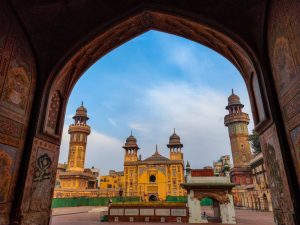
Hammer-Head Beach, Amazing view of Gwadar city.
October 26, 2021
Princess of Hope, Hingol National Park
October 26, 2021
A short walk away from the Delhi Gate of Lahore, you will see a glorious monumental ensemble of the Wazir Khan mosque that grabs the attention of the tourists. The majestic mosque was constructed by the governor (Wazir) of Lahore, Hakim Shaikh Ilm-ud-din Ansari during the reign of Mughal Emperor Shah Jahan in 1634 and completed in 1641. The mosque takes its name from its builder and Shah Jahan himself inaugurated the mosque in Lahore.
The mosque is surrounded by a buzzing bazaar that is still in bloom with markets, haggling voices, and car horns.
The rectangular mosque measures approximately 86.17 x 50.44m comprising four domes at each corner of the mosque. When you walk inside the mosque from the main entrance you will see the exterior of the mosque is embellished with Persian style titles. The walls of the mosque are lined with the calligraphy of Quranic verses and Persian poetry. The mosque is made up of cut and dressed brick decorated with glazed tile mosaics, some of the finest work fresco, Qashani tile, and painting along with mosaic tiles ornately decorated with Kashi-Kari work that was unique at that time. Several archways in the mosque are lined with muqarnas while the rest is lined with Mughal style frescos and decorative tile panels. The floral designs and patterns emerge in symmetrical harmonious waves which bring a sense of tranquility to the mosque’s echoing halls.
The central courtyard of the mosque measures approximately 160 feet by 130 feet, surrounded by twenty-four hujras and two pavilions facing each other across its width. The courtyard also contains a tomb of a renowned Sufi Saint of the 14th century, Syed Muhammad Ishaq Gazruni, also known by the name Miran Badshah who migrated from Iran to Lahore during the Tagluq Dynasty. The prayer chamber is located on the west-most side of the mosque and is approximately 130 feet long and 42 feet wide. It is divided into five compartments aligned into a single long aisle running north to south.
The unique architecture of the mosque gives a glimpse of history and the artisan sense of people at that time. Among the other masterpieces of the Mughal era, Wazir khan holds a significant position.
